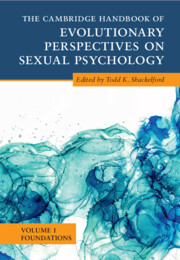Book contents
- The Cambridge Handbook of Evolutionary Perspectives on Sexual Psychology
- The Cambridge Handbook of Evolutionary Perspectives on Sexual Psychology
- Copyright page
- Contents
- Contributors
- Preface
- Part I Foundations of Evolution
- Part II Middle-Level Theories
- 7 Parental Investment Theory
- 8 Parent–Offspring Conflict
- 9 Theory and Evidence for Reciprocal Altruism
- 10 Life History Theory and Mating Strategies
- 11 Sperm Competition Theory
- 12 Sexual Conflict Theory
- 13 Cross-Species Comparisons
- 14 Cross-Cultural Methods in Sexual Psychology
- 15 Behavioral Genetics
- 16 Sex Differences and Sex Similarities
- 17 Individual Differences in Sexual Psychology
- 18 Experimental Methods in Sexual Psychology
- Index
- References
8 - Parent–Offspring Conflict
from Part II - Middle-Level Theories
Published online by Cambridge University Press: 30 June 2022
- The Cambridge Handbook of Evolutionary Perspectives on Sexual Psychology
- The Cambridge Handbook of Evolutionary Perspectives on Sexual Psychology
- Copyright page
- Contents
- Contributors
- Preface
- Part I Foundations of Evolution
- Part II Middle-Level Theories
- 7 Parental Investment Theory
- 8 Parent–Offspring Conflict
- 9 Theory and Evidence for Reciprocal Altruism
- 10 Life History Theory and Mating Strategies
- 11 Sperm Competition Theory
- 12 Sexual Conflict Theory
- 13 Cross-Species Comparisons
- 14 Cross-Cultural Methods in Sexual Psychology
- 15 Behavioral Genetics
- 16 Sex Differences and Sex Similarities
- 17 Individual Differences in Sexual Psychology
- 18 Experimental Methods in Sexual Psychology
- Index
- References
Summary
At first glance, the relationship between parent and offspring seems to begin in perfect harmony. In particular, the image of human parents’ devotion to their infant is one that has been depicted in art for thousands of years. And yet it often seems a sharp contrast to the modern Western image of the adolescent–parent relationship, full of strife and angst. It’s also a contrast to the relatively abrupt end of parent–child relationships seen in many animal species as offspring disperse. Human offspring have a much longer period of juvenile dependence and sometimes don’t disperse very far. But is there a good reason to expect perfect harmony or strife and angst? Parent–offspring conflict theory has informed a wide range of research in nonhuman animals as well as in humans. Both research areas have focused on early maternal–infant conflict, such as prenatal conflict and weaning conflict; however, recent research in humans (as well as research in animals on cooperative breeders) has also highlighted conflict over mate choice. In this chapter we examine these sources of conflict.
- Type
- Chapter
- Information
- Publisher: Cambridge University PressPrint publication year: 2022

